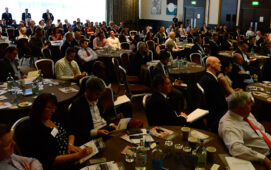Trading firms – especially those into HFT – are always looking for a technology edge, and customised solutions can provide it. The custom approach is what Fiberblaze specialises in, though that’s not stopping it releasing a more generalised product this month. Embracing Altera FPGAs, and opening an office in New York City is also in the plan. IntelligentTradingTechnology.com talked to Fiberblaze’s CEO Troels Gert Nielsen to get the scoop.
Q: First, tell us about Fiberblaze and what you do?
A: Fiberblaze were founded in 2008 and has specialised in developing and manufacturing FPGA-based network interface cards (NICs). We operate primarily within financial high frequency trading (HFT) and telecommunications.
We do FPGA-based data acceleration, but are different from many of the FPGA solution providers in the HFT space in that we do not do managed services, and we are different from many of the other FPGA NIC providers in that we have a significant number of finance-related IP blocks developed in house, including our own ultra low-latency TCP/IP Offload Engine (TOE).
Within HFT, we have historically specialised in customised solutions for die hard low latency customers, but will on September 19, launch a standard TOE product with basically the same speed capabilities – but with no customisation option – in order to reach out to an audience with less need for for customisation – but still within the “die hard” low latency fringe of the market.
Q: As a NIC provider – why does it matter that it is your own TOE (compared to having access to one from an external partner)?
A: This is important in several ways. First of all, it means that we can constantly improve and make changes to our TOE, knowing it in every detail when a client wants specific changes. The TOE takes full advantage of our platform and is tightly integrated into it, to minimise latency.
Secondly, it means that we have complete freedom to use, change and sell it in any way we want. If a client wants us to change or adapt this or that, we can do it immediately without violating any external party’s license agreement and should the client subsequently want access to the source code – because he wants to make future changes himself, after the initial implementation of the TOE – we can give him access to the source code as well.
That freedom and speedy delivery is only possible if you have your own FPGA card design and your own TOE.
Q: So customisation is key to you. Who are your typical clients within HFT?
A: Yes, indeed, customisation is key. We have two typical types of clients:
A typical client could be a customer with a significant technical knowledge within his organisation who is interested in the absolutely fastest possible solution with the lowest latency, in other words the hardcore latency/HFT guys. This customer type does not necessarily want a nicely wrapped solution, but a cut-to-the-bone low-latency solution, sometimes delivered with a relatively crude interface where the client himself then add his own pieces of coding or logic to finalise the solution. We have that cut-to-the-bone TOE and the other needed IP components. In addition, to keeping down his costs related to his continued FPGA development, this type of client could be interested in getting access to the FPGA source code, which we then sell to him.
Another type of client may require a more nicely wrapped solution, but wants, for example, their market data to be processed in a certain manner that the mainstream FPGA suppliers doing managed services do not want to supply. This is because some managed service providers are interested in a relatively homogeneously installed base to facilitate the ongoing service and might not be prepared to deliver the requested changes. Or the customer may want a specific driver that is otherwise not available. Then we make the customised solution they are asking for. As we do not do managed services, we do not have that desire for “as standardised as possible” solutions.
Q: So you even give the clients access to the FPGA source code?
A: Yes, if this is requested by the client we do so in a number of cases, and for a reasonable extra fee.
Q: Before we move into the hardware part, could you disclose any performance figures for your TOE?
A: Generally, when it comes to latency figures, it is important to compare apples to apples and you hear a lot of surprising figures in the market that often are useless or nonsense unless you have the full detailed picture.
We must emphasise the ability to verify the performance with external equipment. Hence our preferred metric for the TOE is the round trip time, which is the Rx time + the Tx time. With a minimal “algorithm” in the server, we measure 2.3 microseconds from tick data entering the 10G interface until the order has been pushed out on the fibre. We have a lot of additional details that we share with clients, and we would be happy to do so upon request.
Q: Tell us a little more about your hardware offerings?
A: Historically, we have been working a lot with Xilinx FPGAs, but we will shortly launch an Altera solution with a Stratix5, 8 GB DDR3, 288 Mb QDRII+ and 2 Gb RLDR3 RAM. On the Xilinx side, we have this month added a 4X10G Virtex6 board with 288 Mb QDRII+ memory to our product range.
Basically, we are impartial about which FPGA platform our solutions are built on and our impression is that the majority of our clients share this approach. However, we have realised that a segment of customers asks specifically for Altera based solutions – and we want to be able to serve that segment as well. Thus, overall we have a wide range of 10G boards that for Virtex6 365T and 240T (with or without QDRII+), Virtex5 110T and 155T boards – and now the above mentioned Altera based solution.
Q: You are based in Copenhagen, Denmark. Are there any plans of opening up offices in the U.S.?
A: Yes, we have just set up a U.S. subsidiary and will open up offices in New York on Madison Avenue next month. A number of our volume clients have asked for this and we find this step obvious as we are increasingly focusing on the HFT segment.
Subscribe to our newsletter




